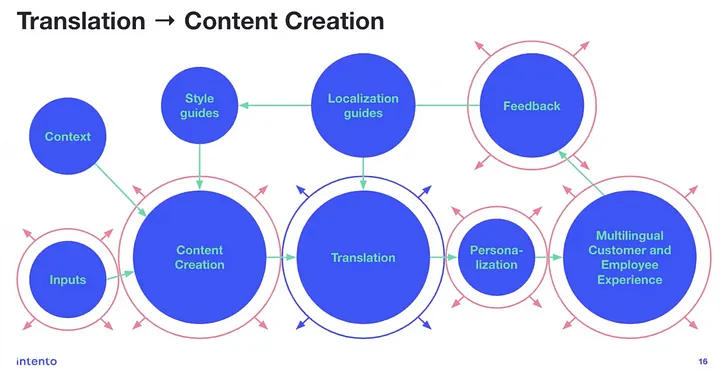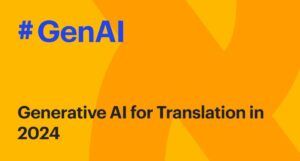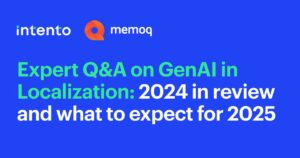The localization industry is rapidly evolving, and GenAI is a big reason why. Experts from Expedia, GoTo, Şişecam, and VMware shared their experiences with AI in localization workflows at our webinar “GPT in Localization: When the tide goes out…”, spotlighting the most significant results.
For those who missed the webinar, this summary provides key takeaways from the panelists’ strategic insights. The full recording of the webinar is available here.
Shifting focus to high-value localization tasks with GenAI

In his keynote, Konstantin Savenkov, Intento’s co-founder and CEO, highlighted the massive impact of large language models on the language industry and introduced the concept of “zooming out” as a strategic method for adapting to innovative technology and maintaining a competitive edge.
“Zooming out is the best approach to new technology. You have more time on the more important things, but keep the original task in your scope, as it costs you close to nothing, thanks to automation. It gives you an upper hand in any competition, be it a business competition or an internal competition,” Konstantin explained, emphasizing that the emergence of large language models is a perfect case for applying this zooming out technique.
As we shared on our previous webinar in December 2022, even before GPT-4, advanced automation in localization expanded beyond Machine Translation to include Source Quality Improvement, Automatic Post-Editing, and Translation Quality Estimation. These pillars empower localization teams to address diverse translation use cases.
Today, technology advances further, providing a path to a bigger zoom-out. With translation sufficiently automated, localization leaders can look at a bigger scope. Creating content based on inputs, context, and style guides. Making sure the content created across the company fits all the requirements. Translating the content, checking that it aligns with guidelines. Presenting it to users in a culture and identity-aware, personalized fashion. Analyzing user experience, or “language experience”, collecting feedback, and then incorporating it into the process.
Gain insight into the challenges, benefits, and real-life examples of applying generative AI to localization across various sectors and languages, as shared first-hand by industry experts from top global companies.
Overcoming complex syntax and maintaining brand voice with GenAI at Şişecam
Şişecam, a leading Turkish global glass manufacturer, operating in 14 countries and selling in 150+ countries. Olga Hergül, Global Content and Localization Program Manager at Şişecam, shared that they maintaining a consistent brand voice for its linguistically diverse audience is challenging due to the intricate Turkish syntax. Recently, she has been exploring the potential of large language models like OpenAI’s GPT.
Although they haven’t yet deployed any workflows involving large language models into production, Şişecam has been testing the technology for two primary use cases: Source Quality Improvement and Automatic Post-Editing.
“With generative AI, we tested different process combinations, such as source quality improvement for Turkish plus machine translation, or machine translation plus automated post-editing for English, or all three stages in a row,” Olga Hergül, localization program manager at Şişecam, elaborates. “The initial results have been quite promising, with AI working surprisingly well for Turkish in terms of source quality improvement.”
Yet, there’s a catch. Although GPT performed well for corporate communications, such as internal regulations and employee communications, requiring minimal or no human intervention in some cases, it sometimes can alter the tone of voice and style, particularly in content like press releases or interviews.
That’s why Olga emphasized the need to adjust style guides for large language models. This way, Şişecam’s content can stay true to its brand identity and still connect with diverse audiences.
Summing up her observations, Olga said that Şişecam is eager to further test and implement GPT or alternative large language models into localization workflows.
Achieving cost-effective, high-quality content with GPT and Whisper at VMware
Bodo Vahldieck, Senior Globalization Quality Manager at VMware, described how they explore the potential of GenAI tools like GPT and Whisper to enhance VMware localization program. They aim to improve source content, streamline processes, and speed up reference process management while maintaining top-notch content quality standards and integrating AI with current workflows.
By adopting AI, VMware aims to save costs, speed up turnaround times, and maintain consistent quality. Bodo recognizes AI’s potential to improve linguistic quality, eliminate unnecessary words, and enhance speech recognition accuracy.
“With AI, we see now for the first time we can give the authors a tool to check errors in the source text,” Bodo Vahldieck, Senior Globalization Quality Manager, states, emphasizing the importance of improving source text, involving authors in the process, and making the process more visible
They are exploring the automation of source content quality improvement and considering implementing AI-powered translation services in production. Also, VMware is evaluating OpenAI’s Whisper technology to advance speech recognition and refine spoken language in video subtitles. In their current workflows, human reviewers play a crucial role in post-translation stages, detecting and addressing quality concerns.
VMware’s approach to creating cost-effective, high-quality content is a blend of teamwork, AI innovation, and the right balance of AI technologies with human expertise. By further enhancing its processes with cutting-edge AI technology and data analysis, VMware seeks to advance its marketing localization efforts, deliver top-quality results, and improve turnaround times.
Streamlining GoTo’s marketing localization with GenAI
Hartmut von Berg, Senior Director of Localization at GoTo, a company known for its conferencing and IT support products, has been exploring the potential of GenAI technology for marketing localization. Following its rebranding from LogMeIn, the company is now integrating AI technology into its marketing localization strategies. This technology has been tested in a beta product to create compelling customer campaigns. Their prior AI experience mainly focused on translating technical documents, prioritizing information communication, and addressing user concerns over fluency and accuracy.
GoTo prioritizes adapting content without compromising brand guidelines for enhanced quality assurance and market adaptation. Hartmut von Berg, Senior Director of Localization at the company, shares their strategy for establishing consistent brand localization guidelines and implementing powerful GenAI for quality assurance.
GoTo is exploring running their own GPT instance and applying an intentional bias to achieve accurate and personalized results without external biases from large corporations like Apple or Microsoft. In collaboration with Intento, they aim to assess the potential of AI in marketing localization and identify the most effective method for incorporating it into their workflow.
However, they must overcome challenges such as altering style guides to match GPT comprehension, handling repetitive terminology that defines their brand voice, and navigating country and culture-specific biases.
“We believe now we need to rewrite [the brand guidelines] and tailor them for the machine to get the best results out of it,” Hartmut states.
He also noted that breaking down large guidelines into smaller, meaningful blocks can enhance AI’s attention and focus on specific aspects, while finding that inclusivity and formality are more easily detected, and other aspects may necessitate further fine-tuning.
Despite these challenges, GoTo’s mix of human expertise and AI is designed to deliver an engaging and culturally relevant user experience. This approach streamlines the localization process and unleashes the full potential of AI-assisted localization, helping GoTo maintain a consistent brand identity across various markets.
Expedia’s transliteration and dialect conversion improvements using GenAI
Tommaso Rossi, Expedia’s Head of Localization, discussed using early access to GPT to enhance their global travel platform. After integrating the AI-powered connector for personalized trip suggestions, Expedia is now exploring GPT’s potential for localization in over 20 languages.
Initial tests for multilingual content creation showed that the technology is not yet ready for off-the-shelf use, requiring additional human assistance in fact-checking and aligning with industry-specific terminology. Rossi highlighted the significance of prompt engineering in improving GPT’s output quality and determined that GPT is comparable to their current machine translation providers.
Rossi also noted that the quality produced by GPT is very much comparable to the machine translation engines they’re currently using, adding that “this means that potentially with further testing, we could discover that with one solution, which is the GPT technology, we could potentially reach the same level [of quality] that we get by [using] the right [MT] engine for the right language pair and the language content type across the board.”
Rossi also said GPT stands out in transliteration and dialect conversion, making it a promising field compared to traditional machine translation methods. Initial tests on geography content and dialect conversions, like switching from US English to UK English, showed promising results with minimal errors and high accuracy. Plus, GPT has proven its success in transliteration for languages like Japanese, Chinese, Korean, Greek, and Hebrew. Expedia is keen on further testing and exploring advanced methods for different types of content.
His team now plans to refine their testing and implementation strategies to improve localization, content creation, and user experience. As they continue exploring GPT’s potential, users worldwide can benefit from enhancements in Expedia’s multilingual services.
Key takeaways and prospects
Generative AI tools, including large language models and automation, can help localization professionals focus on strategic tasks and streamline workflows while effectively addressing complex syntax, brand voice consistency, content quality, and customization for target markets.
Using GenAI leads to faster turnarounds, better results, and reduced human effort across different languages, industries, and contexts. The future of localization relies on continuous learning, adaptation, and experimentation with this innovative technology.
As we move forward, it is essential for industry players to stay informed, engage with emerging technologies, and adapt their strategies accordingly. In doing so, they can drive innovation, ensuring that products and services resonate deeply with diverse audiences worldwide, ultimately contributing to the growth and success of their organizations.



